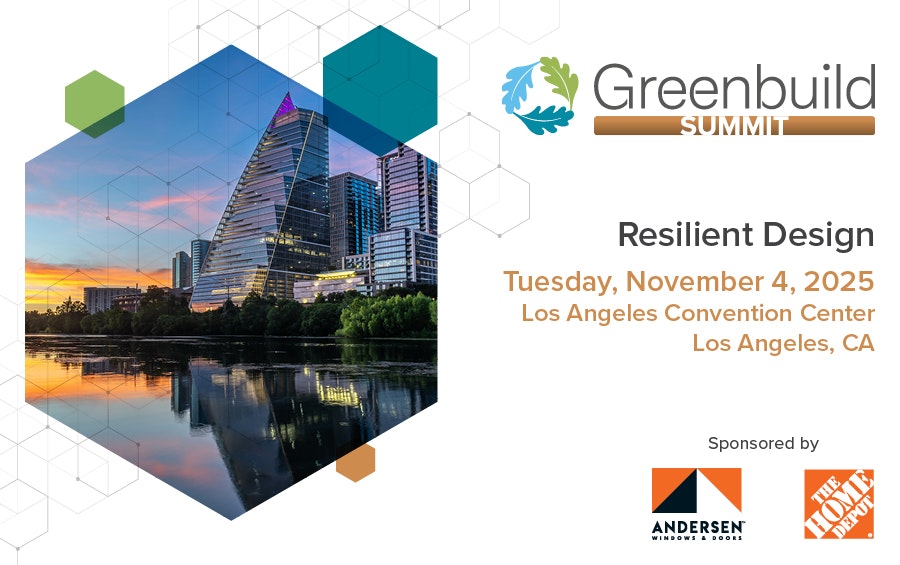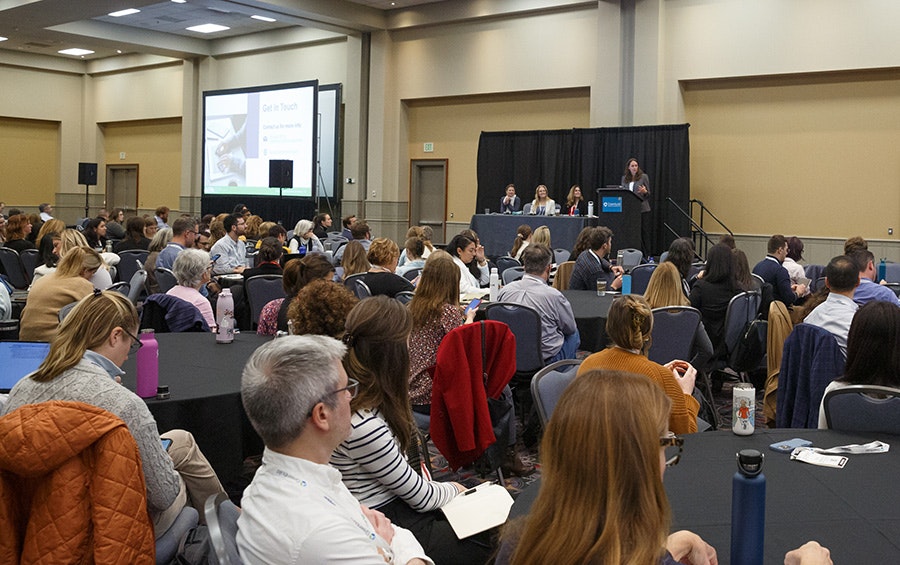Resilient Design Summit
A technical deep-dive into creating resilient structures.
Tuesday, November 4, 2025, at the Los Angeles Convention Center

Building a Resilient Future
Intensifying wildfires, increasing flood risks, and record-breaking heatwaves are reshaping how we think about building performance.
As climate hazards escalate, the ability of buildings to protect occupants and maintain functionality is essential to resilience planning.
This Summit explores how buildings can be designed and retrofitted to withstand the growing threats of fire, flood, and heat.
What to Expect
CE-Accredited Sessions
Greenbuild's Summit Working Group has programmed an in-depth session that will give attendees an inside look successful designs for resilient buildings. This all-day Summit will give attendees the chance to dive into real-world applications and how building for resilience can save money and benefit building projects.
Continuing education credits are available for Greenbuild's in-person summits.
Who Will You Hear From?
Our summit speakers bring their expertise, specialized knowledge and experience to the room for a focused learning experience like no other.
With CEOs, CIOs, Presidents, Vice Presidents, Partners and various other sustainability leaders taking to the stage, you couldn't be in better company.
Who Will You Meet?
Greenbuild features a cutting-edge community of global green building professionals looking to improve sustainability, resilience, equity, health and wellness in the spaces we live, work, play and learn. Take a look at who you'll meet at a Greenbuild summit.
Summit Sessions
Foundations of Resilience: Understanding the Climate Resilience Assessment in LEED v5
As climate-related threats to the built environment become increasingly urgent, LEED v5 introduces a groundbreaking Climate Resilience Assessment prerequisite, marking the first time that climate risk evaluation is required at the outset of project design. This session will provide an in-depth overview of this foundational prerequisite, which is designed to help project teams identify location-specific climate hazards and align design responses accordingly.
Panelists will demystify the assessment process, outline expectations for documentation and interdisciplinary collaboration, and explore how the prerequisite connects to other LEED v5 credits related to hazards such as flood, fire, and extreme heat, as well as long-term adaptive capacity. As the opening session in a series focused on resilience in LEED v5, this discussion sets the stage for deeper dives into specific hazard mitigation strategies.
Whether you're a designer, engineer, owner, or consultant, this session will clarify how to approach climate vulnerability and site-specific risk through the LEED lens and empower teams to make resilience a core part of sustainable design from day one.
Learning Objectives
- Describe the intent and structure of the LEED v5 Climate Resilience Assessment prerequisite and how it differs from prior resilience-related guidance in LEED.
- Understand the role of assessment tools, local climate data, risk analysis, and interdisciplinary expertise in conducting an effective climate resilience assessment.
- Identify how the Climate Resilience Assessment connects with downstream LEED v5 credits and site-specific strategies for managing hazards such as fire, flood, extreme heat, and others.
- Prepare your project team to integrate resilience planning early in the design process to meet the LEED v5 BD+C requirements and elevate long-term building performance.
Cooling the Built Environment: Addressing Extreme Heat through LEED v5
Extreme heat is now the deadliest climate hazard in the U.S.—and one of the most pressing for urban environments. This session dives into the role of LEED v5 in addressing heat resilience through a dynamic panel of experts in community resilience planning, building and site design, and construction workforce health. Panelists will share strategies for reducing urban heat through material choices, passive cooling techniques, shading, and nature-based solutions, while also addressing the protection of outdoor workers and the need for equitable access to cooling. The discussion will highlight how these interventions intersect with LEED v5 credit pathways and broader goals for health, energy performance, and social equity.
Learning Objectives
- Apply the concepts of LEED v5 credits Enhanced Resilient Site Design and Resilient Spaces for extreme heat mitigation strategies
- Understand the links between heat mitigation, health, energy, and equity goals.
- Identify tools and metrics to assess thermal performance and inform early design decisions.
- Describe how diverse stakeholders can collaboratively implement equitable cooling solutions.
Designing for Wildfire Resilience: Integrating Fire Risk Mitigation through LEED v5
Fire is a natural part of the landscape, like wind and rain, that cannot be eliminated. Protecting buildings from rain and wind is not done by trying to stop the rain or wind but rather by designing buildings and their surroundings to be resilient to these impacts. We need to take a similar approach when addressing the impacts of wildfire.
For more than 100 years, communities have been developed with little attention to the risk of wildfire, leaving more than half of residential properties across the US exposed to this risk. Rather than address the vulnerability of homes and communities through sound regulation and design, the national approach focuses on emergency response, tasking local, state and federal firefighters with the role of saving lives and property in increasingly dangerous conditions. Learning from disasters such as the LA fires in January this year is critical to change our approach to how we build communities threatened by wildfire.
Fire is the only natural disaster that not only impacts the built environment but where the built environment impacts and feeds the fire. The amount of fuel available in our buildings leads to fires increasing in size when entering the built environment. It is not enough to focus just on each individual building in the design phase but instead consider the community as one system where each building can impact the fire experience of the others. Community planning is a necessary part of creating wildfire resilience. It is also a critical component to ensure proper evacuation routes for all residents.
This session will bring all these topics together and explore how LEED v5 supports teams in addressing fire risk through intentional planning, design, and choice of materials
See more
Learning Objectives
- Identify how LEED v5 encourages design responses to site-specific fire hazards identified in the Climate Resilience Assessment.
- Explore best practices in landscape design, defensible space, and material choices for wildfire risk reduction.
- Analyze case studies that demonstrate integrated fire-resilience strategies across building types and climates.
- Understand documentation and interdisciplinary coordination requirements related to fire resilience in LEED v5.
Your Building Won’t Float: A Hands-On Resilience Sprint for LEED v5 Flood Mitigation
This session immerses participants in an unexpected flooding resilience scenario and engages them in co-creating LEED v5-aligned strategies under guidance. The experience simulates high-stakes design conditions while leveraging the latest resilience criteria from LEED v5. Participants walk away with frameworks, contacts, and unexpected partnerships they can use in their own work.
Learning Objectives
- Interpret and apply LEED v5 flooding resilience credits in practical design contexts.
- Collaboratively strategize flood resilience solutions for extreme or edge-case urban conditions.
- Use scenario-based decision tools to prioritize adaptive infrastructure and green design.
- Engage stakeholders using dynamic planning models under climate stressors.
Secure Your Spot
Greenbuild's Summits offer a technical, hands-on course where you can work directly with experts and peers on critical topics impacting our industry.
Summits included in Conference and Student Passes
Summit Working Group Members
The Greenbuild Summit Working Group consists of green building experts that advises our conference and program team on all aspects of our 2025 Summits, ensuring Greenbuild is at the forefront of the industry.
- Karema Enos, Associate Director, LEED Technical Development, U.S. Green Building Council
- Birgitte Messerschmidt, Director, Research, NFPA
- Philip Donovan, Partner/Director, Regen CoLab, Little
- Alan Scott, Director of Sustainability, Building Science Solutions, Intertek
- Lindsey Machamer, Project Management Supervisor, Parks & Recreation, City of Austin
- Jennifer Sanguinetti, Vice-President, Facilities and Campus Planning, Simon Fraser University
Summit Sponsorship Available
Guarantee that the green building industry identifies you as a partner by sponsoring one of Greenbuild's Summits or Workshops taking place Tuesday, November 4, 2025, at the Los Angeles Convention Center.
Eric Peterson
Sponsorship Opportunities
202.256.0939
eric.peterson@informa.com




